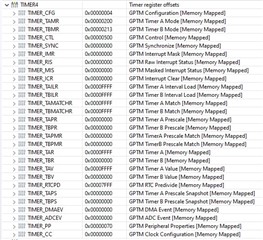工具与软件:
我正在尝试对端口 D7上的一个脉冲序列进行计数。 代码:
SysCtlPeripheralEnable (SYSCTL_PERIPH_GPIOD);
SysCtlPeripheralEnable (SYSCTL_PERIPH_TIMER4);
GPIOPinTypeTimer (GPIO_PORTD_BASE、0x80);
GPIOPinConfigure (GPIO_PD7_T4CCP1);
//此处运行了大量的代码、因此外设已准备就绪。
TimerDisable (TIMER4_BASE、TIMER_B)
TimerConfigure (TIMER4_BASE、TIMER_CFG_SPLIT_PAIR | TIMER_CFG_B_CAP_COUNT_UP | TIMER_CFG_B_ACT_NONE);
TimerControlEvent (TIMER4_BASE、TIMER_B、TIMER_EVENT_NEG_EDGE);
TimerEnable (TIMER4_BASE、TIMER_B)
TIMER4_TBV_R = 0;
//每1/4秒...
count = TimerValueGet (TIMER4_BASE、TIMER_B);
TIMER4_TBV_R = 0;
但 Count 始终为零。
谢谢、Doug


